Part 7 - Fort Jameson and Nyasaland
Fort Jameson
I travelled to Fort Jameson in 1955 where I had the job of
building six small concrete bridges between there and Dedza. This
was a different setup from the bridges I had worked on with my
father a few years before. I was now working for a major contractor
with all the backup I needed. Machinery and materials delivered
to site as required although communications were still primitive,
using telegrams from the nearest centre sometimes 40 miles away
from the bridges.
I drove up the Great East Road in my little Morris Minor and
enjoyed the change of scenery with more hills and escarpments
than I had seen for some time.
In Fort Jameson I met up with some old friends and some friends
of my parents. Barry Ledger was one of those. He was a policeman
and had an MG TD, I think it was. Following him one day back from
the club through Fort J, I forgot that I could not corner like
him and knocked a back wheel off my car!! I remember him well
for another reason too. I was feeling very depressed after a broken
love-affair and after another visit to the club we were in his
house where I was saying life was not worth living!! He produced
his .38 revolver and fired a shot into the fireplace then handed
it to me saying, "go ahead, finish it". I remember well
very nearly 'doing the deed' just to show him how seriously he
had underestimated the way I felt.
In the years since I have often thought of that occasion with
horror at how close I came to missing out on all the fascinating
things I have been involved in since.
Work soon made me forget my miseries and I began enjoying
life again. I did not get a lot of hunting and there was not nearly
so much game in that area as in Northern Province but I kept the
pot full with plenty of duiker, reedbuck, warthog and guinea-fowl
as well as buying chickens, sheep and eggs locally. I had a small
caravan at a central bridge and visited the other bridges from
there. I acquired a puppy which I called Rory because all my previous
dogs which I had called Jock had come to sticky ends. Rory stayed
with me for years and was a great companion.
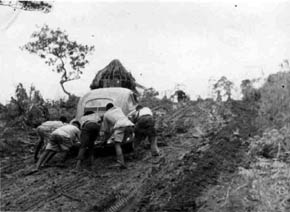
Bridge Deviation!
I remember a small 'rest house' near the N.RNyasaland
border that I used to visit, where the owner Mr DeSouza served
the most wonderful Samouzas and ever since I have remembered "DaSouza's
Samouzas" with pleasure.
Crocodile Hunting
After finishing the bridges I moved to Blantyre for a contract
at Liwonde on the Shire river downstream of Lake Malombwe. The
river is the only outlet from 400 mile long Lake Nyasa and the
company had a contract to build a bund (dam) across it. The building
was a tremendous undertaking which cost over £50,000 and
involved 100,000 cubic yards of earth dam across 1,120 ft width.
The purpose was to act as a coffer dam for investigation and building
of a permanent barrage for a hydro-electric scheme at Matope,
some 40 miles downstream from Liwonde. The investigations showed
that the scheme would cost tens of millions of pounds which the
Federal Government could not afford whilst the Kariba Hydro-Electric
Scheme was being built, so that the decision was taken to shelve
the Shire Valley Project for at least four years. In view of this
it was decided that the bund would be breached in August 1957
to return the river flow to it's normal pattern. The breaching
was a major undertaking to avoid flooding and damage downstream
and had to be controlled very carefully. I will not go into the
details but it was a very exciting operation trying to stop the
erosion of the banks from getting out of hand.
I lived in my caravan on site and as we steadily closed off
the flow in the river and the downstream water level fell, crocodile
hunters appeared and took advantage of the lower levels to shoot
the crocodiles. Some of the hunters stayed with me and I went
out hunting with them at night.
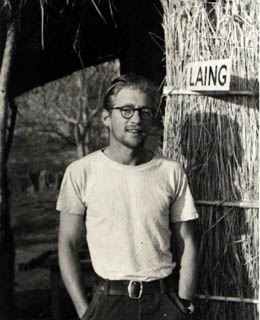
The business of hunting crocodiles in the wild was a new experience
for me and is worthy of a description to itself.
There were no crowded sandbanks with crocs, as sometimes seen
in film, waiting to be picked off at long range. They move so
fast and clear into the water at any disturbance that it would
not be possible anyway to get a decent 'bag'.
We shot at night using small flat-bottomed boats usually powered
by a single paddler in the stern. We cruised as quietly as possible
about 50 yards offshore using a 'bulala' lamp strapped on our
heads. The crocodile's eyes shone a brilliant red in the light
and one could learn roughly the size of the croc by the spacing
of the eyes. Very small crocs had very bright eyes and more greeny
in colour.
I used a 9.3 mm rifle with open sights, blackened with soot
to avoid reflections. We had to shoot from about 10 yds because
when clean shot in the brain, which is only about the size of
a matchbox, they would thrash about and then sink to the bottom
after about 5 seconds so we had to get hold of them before they
sank. Once below the surface they would not float up until 12-18
hrs later and would be belly-up where the sun would ruin the skin.
If you were in moving water, such as a river, they would surface
miles away and be lost.
Crocodiles under 4' in length were known as hornbacks and
the skin from their whole body was used, including the back, but
with anything larger only the white belly skin was used.
The skins were carefully taken off as any cuts reduced the
value. They were dressed with rough salt and neatly rolled up
to go to 'market'. At that time skins brought in about £1
per foot in length (or £1 per inch belly width which worked
out very much the same). A hunter could get 20-30 feet each night
in a good area which amounted to a lot of money in those days.
When shot and roped a very large croc would be towed to the
nearest beach for skinning in the morning but smaller ones were
pulled into the boat.
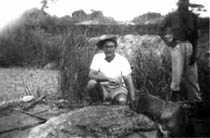
On a few occasions the shot was not immediately fatal and
the croc recovered enough to thrash around after being brought
into the boat, which was not much longer than they were. This
was a frightening experience as their reaction is to roll over
and over in the same way as they tear flesh out of any kill they
have made. You can imagine the result in the confines of a small
boat, in pitch darkness out on the water with the snapping of
its tooth-full jaws and threatening to overturn the boat as it
rolled over the side!!
Any new paddlers we employed were first 'tested' by getting
them to pull 'grunters' from the water with their hands. Grunters
were baby crocs about 2 feet long which lay quietly in amongst
weeds, usually in groups. They had very sharp teeth. They made
a grunting sound when caught. I cannot remember being aware that
this call was probably to alert their parents that they were under
threat!!!
My main crocodile hunter friend was Brian Marsh, from Salisbury,
and we shot together for 3 months in 1957. After the building
of the Liwonde bund had been completed the company was obliged
to be on standby to re-open the dam if the lake water level exceeded
its 1936(?) flood level of, if I remember correctly, 1556.6 feet
above sea level, and therefore I was able to go crocodile hunting
with Brian Marsh while watching the lake level.
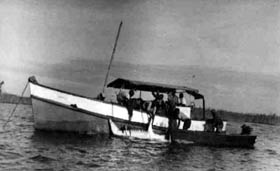
We had a 30 foot base boat loaded with supplies and salt and
towed two 12 flat-bottomed shooting boats. We covered an area
from the southern end of the lake up through Monkey Bay to Dormira
bay 100 miles north and also went across to the East side of the
lake, the Portuguese side where we had the experience of rescuing
many Africans from the water when a Dhow sank in a storm. Unfortunately
more than 20 drowned.
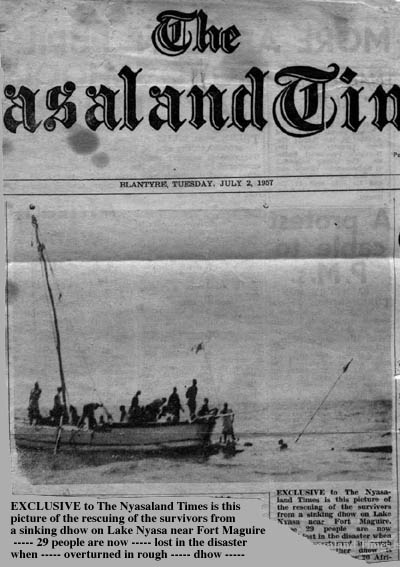
It was here on the East side that, because there were not
many crocs, we decided to shoot a hippo as a bait attraction for
crocodiles. We did get a few, and watching them thrashing around
with their violent rolling movement to tear the flesh from the
hippo carcass was a dramatic sight.
Near Cape Maclear an island called Mumbo had some caves in
which we found large crocodiles. We had to use dug-out canoes
in there. This was somewhat scary!!
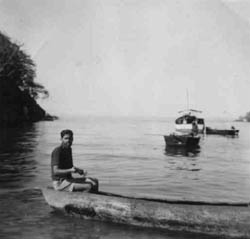
Brian Marsh at Mumbo Island
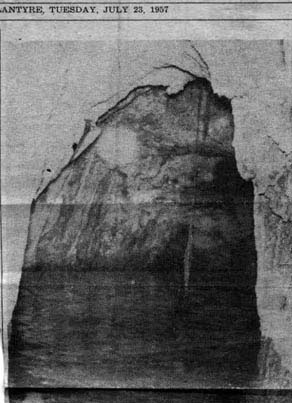

'CROCODILE HUNTERS on Lake Nyasa often venture
into what
must be the most dangerous hunting grounds on the Lake. They
are the caves on Mumba Island near Cape Maclear. The Cave
pictured above goes in about 100yd., broadening into a cavern
about 20ft. high. Small caves lead off and are populated by
crocodiles. The hunters have to go in canoes and would stand
little chance if the canoe capsized. Below is seen Mr. Roy
Williams, who with Mr. Brian Marsh secured a 14ft. 5in. crocodile
after shooting it in the cave.'
(Nyasaland Times Tuesday, July 23, 1957)
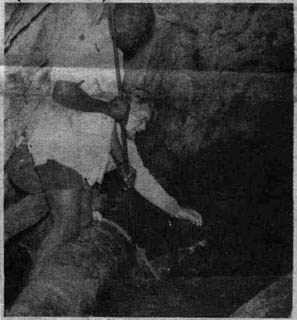
'Normal' hunting was done in complete silence in the early
hours of the morning, the only sounds being in the distance, lions
roaring or 'coughing', hyenas and jackals, and the sound of drums
from far away, until hippos were in the area. We could hear the
chomp, chomp, chomp of their racing through the weeds then into
the water, followed by several minutes of total silence. Then,
terrifyingly a burst of water, sometimes only a few feet away
from the boat, and the great opening jaws of these very large
creatures.
It was the total shock of this change from absolute silence
to their dramatic appearance that I could not come to terms with
and prevented me from taking up crocodile hunting permanently.
Sometimes the 'stalk' of a particular crocodile took a long
time. The reflection of the eyes could be seen brightly until
we were quite close when they faded but often only the tip of
the snout and the 'brain box', about 3 inches behind the eyes
and only about one inch high were all that showed above water.
A very small target! After sighting its eyes we would silently
paddle towards it. Often they would just slide out of sight without
a ripple and would re-appear equally silently some distance away,
after anything up to half an hour. This sequence could go on for
hours but generally, with patience we would get him. Occasionally
a croc would take fright and disappear with an enormous splashing
of the tail and I found it was no good waiting for that one to
re-appear. We experimented with different coloured lamps and a
reddish one seemed to bother them least.
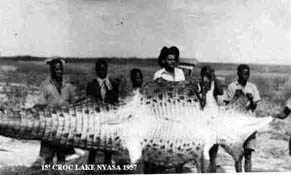
The sale of the skins gave me some spare cash for
the first time and I decided to invest in a new car. I chose an
Austin Westminster, which was one of the few British cars with
a six-cylinder engine. I loved it. I had finally got a new car
of my own, a good job and I, with my dog Rory, started getting
around Zomba, Blantyre, Limbe.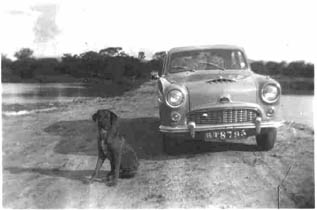
Rory and the Westminster on top of the dam.
Christmas 1957 I did my first long trip, from Blantyre to
Broken Hill, 730 miles, in 12 hours. The only bit of tarmac on
the whole journey was Cairo Road in Lusaka. Not even 'strips'.
(Remember those??)
It was a great trip, even in the rainy season and one of the
drives I remember with great pleasure, until, on the return journey
while driving like Stirling Moss up the Rufunsa escarpment a big-end
bearing went: or so I thought. The engine was knocking badly and
I had to stop! I managed to get a lift to Fort Jamieson where
I arranged for the car to be recovered and towed to the agents
in Blantyre.
The problem turned out to be a strap in the sump which had
come loose and was being hit by a big-end bearing. I could have
driven in home had I known.
I visited Zomba from Liwonde bund when not hunting and was
a frequent visitor to the 'Pig and Whistle' hotel there. It was
a typically English-type pub and used frequently by the army officers
who had their headquarters in Zomba.
After one visit there I was driving to Blantyre when my car
rolled over, seven times. I was fortunately thrown clear and only
had minor injuries but the car was a total write-off. It was less
than six months old but the habitually soft Austin suspension
could not take the corrugated roads and the front suspension had
collapsed. As a replacement I decided on something that would
not turn over so easily and ordered an MGA with a detachable hard
top. Whilst waiting for this to arrive from UK the garage loaned
me a 'Fiat Belvedere station wagon'.
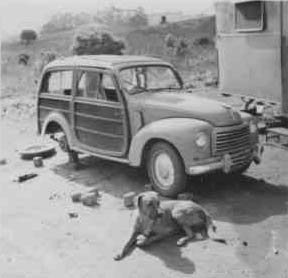
Fiat Belvedere station wagon
This was one of the funniest cars I have ever had. The 'station
wagon' part of it was only large enough to hold my dog with his
head bent. The tiny engine sounded like a sewing machine but revved
wildly and never gave trouble. The tyres were more like motorbike
tyres and I had more punctures than all my other cars put together,
but I enjoyed driving this toy.
I was now working near Blantyre building railway sidings and
school sports fields. From my caravan parked on site I could see
the railway line from Beira and finally after three months waiting
I saw my MG on a wagon passing in front of me. It was the first
MGA in Nyasaland or Northern Rhodesia and I loved it right from
the start and was to have many great drives over all kinds of
roads that one would never believe suitable for a little low-slung
sports car, and never had any trouble. It coped with corrugations
and potholes and was always fun to drive. It cost me £873!!!
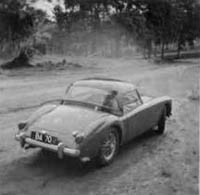
My MGA in its prime.
Having finished the Blantyre contracts and established that
Lake Nyasa was safe from flooding, it was time to move on and
I was sent back to NR, to Abercorn in the Northern Province again
and that was the start of another interesting change in my lifestyle.
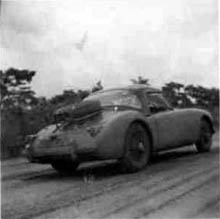
Ready to leave!
Heres to the next time!
(Note.. Rory was ill with a tick-borne sickness but recovered
and stayed with me longer than the MG.)











